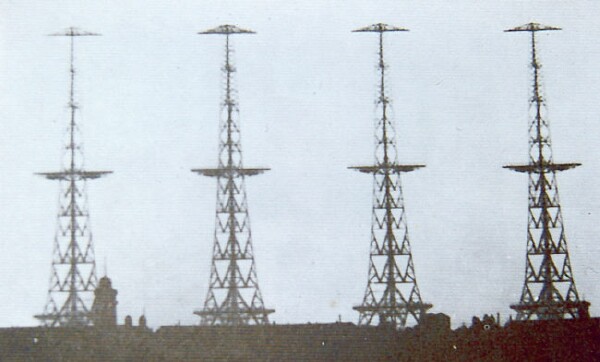
So many storylines run through the Battle of Britain that it’s hard to decide where to start. The evolution of airpower theory in the 1920′s and 1930′s. The secretive growth of the Luftwaffe after the Treaty of Versailles. The design and development of the main mechanical protagonists: the Hawker Hurricane, Supermarine Spitfire, and Messerschmidt 109, as well as the German medium bombers, at least one of which started out as an airliner. British Air Chief Marshal Hugh Dowding, who almost singlehandedly devised and directed a coherent strategy for fighting the battle. German Reichsmarschall Hermann Goring, who did not. The ballroom at Bentley Priory, which was converted into the first real “war room” over two decades before Dr. Strangelove. The female air controllers who served there and elsewhere, constituting an irreplaceable contribution to the war effort every bit as much a part of it as the fighter pilots. Those pilots themselves, including the refugees from conquered lands who ended up being among the highest scoring aces in the battle. A lone democratic island nation against an ascendant continental tribe gripped by an abhorrent ideology. It’s no wonder that it’s one of the most written-about battles in the English language. What if any of those storylines had read differently? Would you be speaking German?
From a game design standpoint, it all starts with radar. In the 1930s, the conventional wisdom was that, in the words of British prime minister Stanley Baldwin, “the bomber will always get through”. Richard Hough and Denis Richards wrote The Battle of Britain: The Greatest Air Battle of World War II in 1989, just in time for the 50th anniversary. Richards had previously written the official three-volume history of the RAF from 1939-45, and the more recent book is an excellent, methodical recounting of the history of the battle, riddled as it is with Britishisms. They lay out the problem — and its solution — very clearly.
With every increase in the speed of aircraft — and of the approaching bomber — the problem of securing good early warning of attack became more and more acute. In the early 1930s it seemed unlikely that anything could provide the RAF in Britain with warning before, as in 1918, the enemy came within sight and sound — a crippling handicap to the defense of the coastal regions and the capital. But, just as the press of the crisis — the rise of Nazi Germany — led to the flight of the 300+ mph eight-gun Hurricane in 1935, so in that same year of renaissance began an equally revolutionary improvement in the early-warning system.
During the early 1920s sound locators of intermittent performance and a range of eight miles or so had been installed on Britain’s south coast, and later there were experiments with outsized locators, curved concrete rectangles dubbed “acoustical mirrors.” Construction in series would have been a major task — the “prototype” at Hythe was 200 feet long. All sound locators, however, gave only the most limited help. Quite apart from their short range, in some conditions they did not work at all, and at times they suffered from the interference of general noise — anything from seagulls and breaking waves to the human voice and passing cars.
More fruitfully, it had been noted from time to time that passing aircraft sometimes interfered with radio signals. A somewhat wild hope was also being expressed that radio waves might detonate the bombs of enemy aircraft before they reached their target, or that some form of electro-magnetic “death ray” might kill the aircrew. To examine such theories and the general application of science to air defence, the Air Ministry towards the end of 1934 set up a small body officially entitled the Committee for the Scientific Survey of Air Defence. The Air Ministry members were two scientists from within Dowding’s Research and Development Department — the Director of Scientific Research, H.E. Wimperis, and his assistant, A.P. Rowe, who had initiated the idea of bringing in outside help and who acted as secretary. The outside members, entirely unpaid, were three scientists of great distinction: Henry Tizard, Rector of the Imperial College of Science and Technology and chairman of the old-established Aeronautical Research Committee; Professor A.V. Hill of University College, London; and Professor P.M.S. Blackett, who had recently discovered the positive electron.
At once they called in Robert Watson-Watt, a brilliant, forty-two-year-old, Scottish-born scientist who headed the Radio Research Branch of the National Physical Laboratory. Confirming their own thoughts, he swiftly brushed aside as boys’ science-fiction stuff any ideas of a death beam — the amount of radiant power required was too “fantastically large.” But following suggestions by his assistant, A.F. Wilkins, by the time of the Committee’s next meeting a month later Watson-Watt was able to produce a paper showing the possibilities of using radio waves not to destroy aircraft, but to detect them. This described lines of research ten years earlier in which the height of the ionosphere above the earth’s surface had been measured by the transmission of radio waves. This had been achieved by noting the length of the interval between the emission of a radio pulse and the return of its “echo,” as registered by a cathode-ray oscillograph. “Why not see if we can bounce radio emissions back off an aircraft?” Watson-Watt asked.
Within a fortnight the Committee had acted on his suggestion. A bomber pilot, who had no idea of the historical nature of his flight, flew his machine up and down above a fixed line corresponding to the lateral centre of the beam transmitted by Daventry’s BBC radio station, while Watson-Watt, Rowe and Wilkins huddled around a receiver to which was attached a cathode-ray oscillograph. As soon as the bomber entered the path of the beam, its presence was registered by the oscillograph. Electro-magnetic energy, it was now proven, was reflected from an aircraft.
By 4 March Wimperis was able to write an astonished minute to Dowding, which began: “We now have in embryo, a new and potent means of detecting the approach of hostile aircraft, one which will be independent of mist, cloud, fog or nightfall.”
I’m sorry to include such a long quote. That’s a lot of italics. Thanks for reading it. I love the death-ray stuff, because it reminds me of how there was an earlier time not really that long ago — around the time my parents were born — when people didn’t really have a good grasp on what science could actually do. Now we all know it’s useful for making social media strategy games, at least ones confined to your browser. But as a scientist, I am tremendously attracted to a time when basic questions of applied science were so simple yet so unanswered. In essence, five or six guys sat down and figured out the solution to a previously intractable problem, which was that bombers had gotten so fast that by the time you had used the old methods to figure out they were coming, you were already being bombed. It’s amazing and chilling, and kind of makes me wish there were a way to bring those days back, when relatively few people could make such a huge difference in a short time, none of whom were on Facebook.
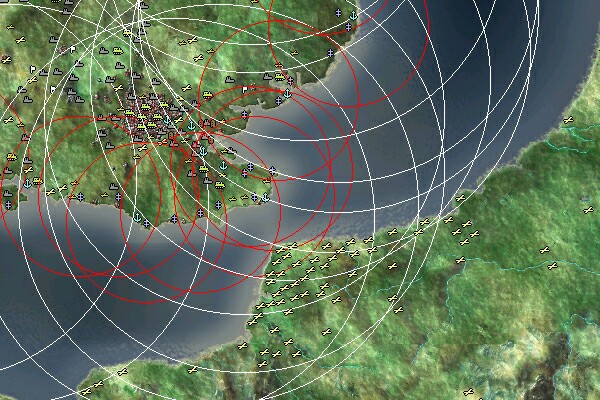
So here’s your radar in Eagle Day. Like in any ultra-realistic real-time strategy game populated by space elves and bionic orks, you can see the actual radius of the technological game effects. It’s the whole paradigm of the genre. The white circles represent the Chain Home stations (codenamed like Bond) depicted in the photo at the top of this article which can detect aircraft flying as low at 3,000 feet, while the smaller red circles are the radius of the Chain Home Low (CHL) stations which detect aircraft down to 500 feet altitude.
RAF also explicitly depicts the radar stations on the game map. Their effects, however, are integrated into a system which reflects the whole problem of detecting and intercepting incoming air raids.
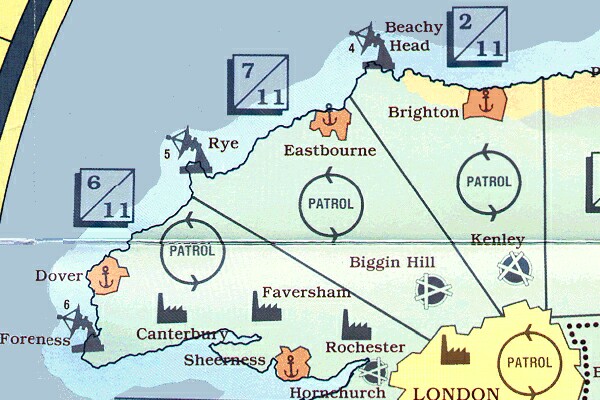
And this is the whole crux of the game design problem in any game about the Battle of Britain. It’s not just about radar, not just about detection, but the problems of detection, interpretation, and reaction. Basically, how to model a fighter control system. Because that’s what the British had that the Germans didn’t expect.
A big misconception about the battle is that radar was some kind of secret weapon that took the Germans by surprise. It didn’t, because the Germans already had their own radar. The otherwise completely awesome 1969 film The Battle of Britain with Michael Caine and Sir Laurence Olivier gets a ton of details right, but in the beginning, when the Germans look through the field telescope across the Channel at the British radar stations and call them a “secret weapon” that the Germans managed to “capture at Dunkirk”, they’re only buggin’.
The Germans had their own radar systems (codenamed “Freya” and “Wurzburg”). They even transported a mobile Freya station to the French coast at Cap Blanc Nez, just across the Channel from Dover, to keep tabs on British shipping. They could see the British radar towers, and knew exactly what they were for. What they didn’t know was how well the British had constructed their fighter control system.
The British fighter control system defined the battle, and any game that doesn’t model this misses the entire point and might as well be about matching variously shaped blocks of different colors, because disrupting the control system itself was the key to Germans winning air superiority. The thing is, they didn’t know how to do it. Fighter Command’s control structure in southern England divided the defense into three groups, each of which were further divided into sectors which had a sector airfield with satellite airstrips. The Sector Ops Room at each sector airfield was connected by secure landline to its Group, which in turn was connected to Fighter Command HQ at Bentley Priory. Operational command rested with each Group, but this information processing system was what enabled Fighter Command to scramble fighters in response to raids rather than having to keep standing patrols flying. Eagle Day calculates everything “under the hood” and then shows you the results for you to act upon.
In West End’s RAF, you need to go through the steps yourself, but you’ll see exactly how you’re being helped (or hindered) by the various factors tied to your early warning system.
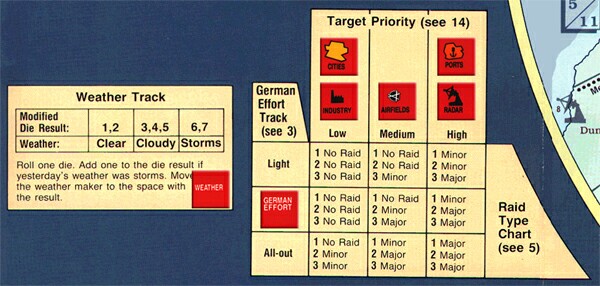
Let’s generate the first raid of the game in RAF. On game-turn 1 the weather is Clear and the German effort is Normal by scenario rule. (From Turn 2 forward, these will be randomly generated.) I draw a target card, which is London. But cities are of Low Priority this early in the campaign (by scenario definition) so cross-referencing Low Priority with Normal Effort gives “No Raid”. I draw again. This time Biggin Hill (an airfield) is the target, with a Strategic Value of 3. Airfields are of Medium Priority. Cross-referencing that on the Raid Chart gives a German Major Raid. Here we go.
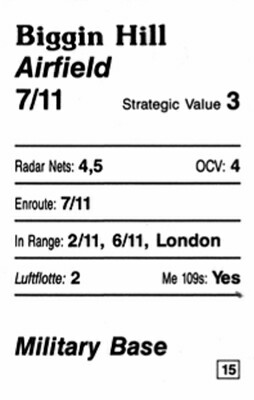
Next comes my British Detection roll, which is a 4. The Observer Corps value (OCV) for the target on the card is 4. In Clear weather you add the full OCV to the Detection Roll, while in Cloudy weather it is halved. There are two radar nets on the card (4 and 5) which are both intact, since it’s the first game-turn. All these are added, so 4 (roll) + 4 (OCV) + 4 (2 for each intact radar net on card) = 12. Oh wait, it’s a major raid. That’s +2. So my Detection Value is 14, which is Medium, Accurate.

I flip a Force card next. It’s a Major Raid, so the card determines that it comprises five Gruppen. Each Gruppe is composed of three Staffeln (squadrons) so that’s a lot of aircraft. If my intelligence were vague, I’d have to deploy my intercepting squadrons now. Because my intelligence is Accurate, I can wait until I see what kinds of planes are involved before I commit my interceptors.
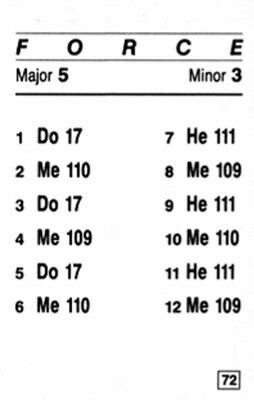
Determining the composition of the raid requires another Force card. Because there are five Gruppen, I take the first five listed on the card: Me-109, Do-17, Me-109, Do-17, Me-109. (Note that if I had drawn this card to determine the size of the raid there would have been twelve Gruppen incoming!)
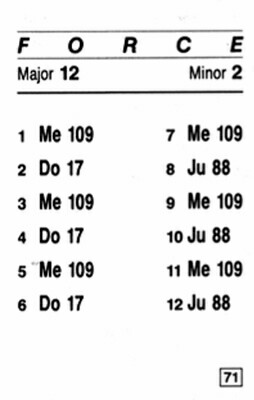
Yowza. That’s a heavily escorted raid. Two bomber groups and three Me-109s. That’s almost a fighter sweep. If you don’t intercept with as many squadrons of fighters as the Germans have escorts, the escorts get to strafe your base. Because I have Medium Warning, I can intercept with any squadrons starting out on the ground on the raid route (“scrambles”) as well as any patrolling aircraft in range. These are spelled out on the Target card, so I know exactly which units I can use. The eligible squadrons are labeled “Patrollers” and “Scramble” in the screenshot. I end up intercepting with two squadrons of Hurricanes.
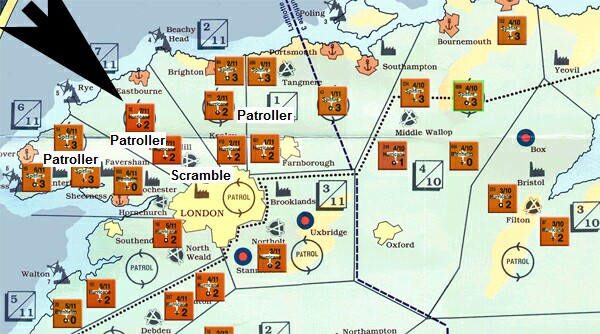
That seems like a lot of fiddle-fiddle just to set up one raid. In Eagle Day, on the other hand, the raids show up, whether you’re ready or not, right on the map. Here’s the start of day 1 in the Eagle Day grand campaign scenario.
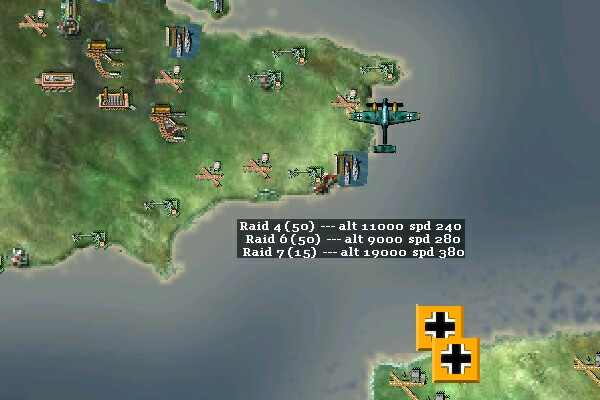
Chits (“blips”) represent raids only detected by radar, while those which have been visually spotted by observers show up as aircraft models. By mousing over a raid, a window pops up with a bunch of information: altitude, size, and speed. The raids just taking off from France aren’t the first raids of the game, but they’re the first significant ones, as the first few were one- or two-plane reconnaissance flights which I didn’t bother intercepting. These three, though, look menacing. My guess is that Raid 4 and Raid 6 are escorted bombers, while Raid 7 is a fighter sweep bringing up the rear. (To be clear, the raid list refers to three blips at the bottom of the screenshot, but two are almost perfectly superimposed. The spotted raid at the top (Raid 5) is nine bombers which I have already separately intercepted.) But I only have radar identification, so I either make a launch decision now while they’re still over the Channel, or wait until I have better information. Unlike in RAF, I’m in (almost) complete control over what I do.
So that’s that, eh? Computers are always better! Who would play a boardgame about this, anyway? The fiddly bits in RAF, though, are important for their Touching History effect. Creating that raid referred me to multiple elements — radar, the Observer Corps, warning level, patrolling squadrons, scrambles, and raid intelligence — that I definitely read about in various books, or saw on The History Channel. RAF presents each element to the player, along with its effects: “Here’s the Observer Corps contribution. Without it you wouldn’t have had Accurate raid intel”. Maybe one of the books you read had a cool story about the Observer Corps. And now here it is in the game. Michael Korda for you:
At this time, radar still gave many false readings, failed to accurately determine height, was an unreliable indicator of the number of aircraft in a formation (hence the importance of the 1,400 Observer Corps outposts, to count them visually once the enemy was in sight), and could not yet distinguish between friendly and enemy aircraft.*
In Eagle Day, on the other hand, things just sort of happen, and you’re not really sure what factors went into the result you saw. On the first day, I had a couple formations fly right over the Kentish coast without resolving from radar blips into spotted formations. I’m sure there was a good reason for that. But it’s buried in the game engine, for better or for worse.
While researching this series, I read a piece on the Royal Air Force Museum website which stated that the Chain Home radar stations only detected outward, that is, across the Channel. But if you look at the radar coverage screenshot above, you’ll see them being 360-degree detectors. Stephen Bungay confirmed this.
RDF [radio direction finding, i.e. radar] was the first detection line, but it pointed out away from Britain’s shores. Once inland, aircraft were tracked visually by the Royal Observer Corps, an organisation which Dowding inherited from the man who set up London’s original air defence system in 1917, Major General E.B. Ashmore. They were also the prime intelligence source for low-flying aircraft who got below the radar net in what is today the standard method for evading detection, a method not systematically used at the time. By 1940 there were about 30,000 observers covering the UK, organised into 50 observer posts in each of 31 groups. Every post had a phone link to its group which in turn was linked to the Observer Corps Centre at Horsham and thence to Fighter Command HQ and Bentley Priory.
OMG totally discredited! But once again, like in many modern computer wargames, this brings up the question of transparency. How can I be sure that what’s happening corresponds to what I think should be happening?
RAF’s transparency has its own drawbacks, some of them serious. How did I know that the raid on Biggin Hill was headed for Biggin Hill? Because it said so on the card. I’m sure real Luftwaffe commanders handed their RAF counterparts little cards with their targets on them, once they had decided where to bomb. (RAF does address this to some degree with “Secondary Target” events.) Eagle Day manages to recreate the immediacy of decision-making beautifully, because it presents you with results, whereas RAF entertains through process. Although sometimes Eagle Day plays like a text adventure. To find out what that means, you’ll have to wait until tomorrow.
__________________________________________
*IFF (“Identification, Friend or Foe”) was instituted just prior to the Battle of Britain via small wireless transmitters on each aircraft.
Discussion
No comments yet.